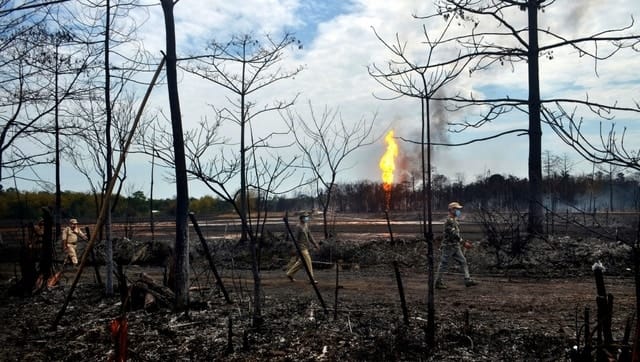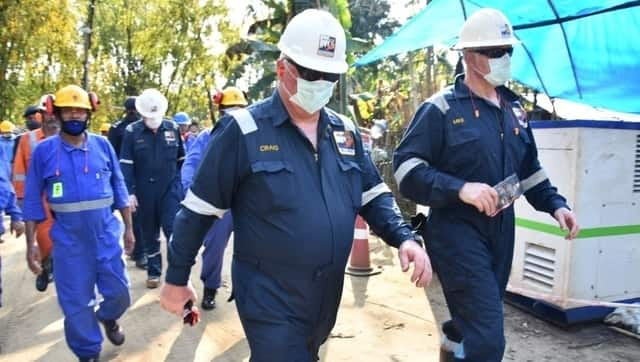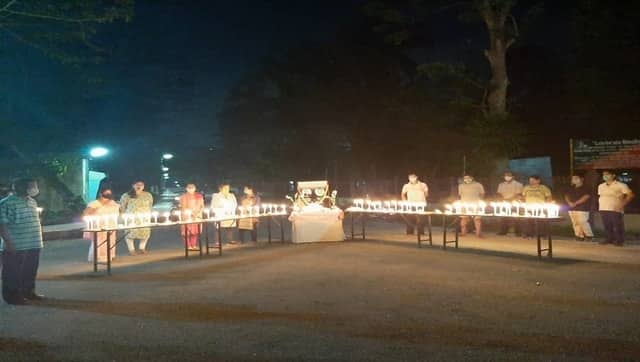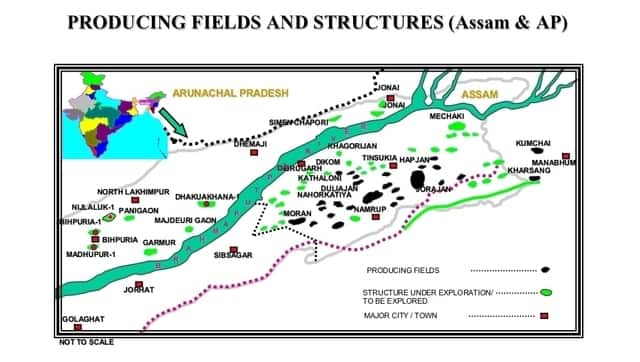When an Oil India official read out the company’s statement hours after a massive fire engulfed Well No 5 at Baghjan oil field and its surrounding areas in Upper Assam’s Tinsukia district, the lack of a human touch was telling. The fear of fire existed for 14 days since 27 May when the well suddenly started spewing out gas uncontrollably after something went wrong during a workover operation. A cold-hearted approach “There are violent protests around the well site. Request was made to Chief Secretary, Govternment of Assam and District Administration, Tinsukia for maintaining law and order so that the experts are allowed to enter the site and start the well control operations. All officials of OIL/ONGC are being evacuated from nearby areas. Once the situation is normal, the experts from ALERT and the staff of OIL/ONGC will move to the site,” the statement said. The violent protests could have been an act out of sheer desperation as people were distraught by the loss of homes, cattle and maybe even livelihoods in front of their eyes. An appeal to maintain calm was the immediate thing the company could have easily done. Before the Baghjan inferno Part of the Oil India Limited’s Greater Chandmari Fields, located approximately 25 kilometres northeast of the Naharkatia field covering an aggregate area of 20 square kilometres, the Baghjan oil field along with the Barekuri and South Chandmari fields have been engaged in active oil production since 2003. The Baghjan BGR Well No 5 is located south-west of Baghjan village and north-west of Dhakuwal in Barekuri where drilling was done up to 4,045 metres for natural gas. It has been said that the Well No 5 at Baghjan oil field, where the blowout happened, started producing crude in 2006. Although the blowout happened on 27 May, 14 days before the catastrophic blaze on 9 June, the first official reaction from the company came only on 29 May.
#OilIndiaLimited’s brief on Baghjan well blow out pic.twitter.com/mJIaAO5JKW
— Oil India Limited (@OilIndiaLimited) May 29, 2020
Significantly, the response came only after Union petroleum minister Dharmendra Pradhan had a detailed discussion with Oil India chairman and managing director Sushil Chandra Mishra and ONGC to find out ways to mitigate the crisis.
Hon’ble Minister, MoP&NG and Steel takes stock of Baghjan Blowout pic.twitter.com/mvDb858OFe
— Oil India Limited (@OilIndiaLimited) May 29, 2020
Despite the seriousness of the situation, the information flow from the company was at best frugal. It was only on 1 June that the company released a statement giving out some details as to the nature of the incident. “At around 10.30 am this morning (27/05/2020) the producing well of Baghjan 5 under Baghjan Oilfield of Oil India Limited in Tinsukia district suddenly became very active while work over operations were on. As a consequence the ongoing operations had to be immediately suspended and the well started releasing natural gas in an uncontrolled manner. All efforts have been made to mobilise men and equipment at the site so that the well can be brought under control. Further, the Crisis Management Team from ONGCL, Nazira has been mobilised to assist OIL’s efforts to control the well at the earliest,” a company release said. [caption id=“attachment_8475621” align=“alignnone” width=“640”]  Fury of fire at Baghjan. Image courtesy MoneyControl[/caption] The public sector company said that the blowout happened when workover operations were carried out by a chartered hire rig firm M/s John Energy under the supervision of Oil India Limited. For the uninitiated, workover process simply implies “the process of performing major maintenance or remedial treatments on an oil or gas well” and blowout means “uncontrolled flow of formation fluids from a well”.
Baghjan2 Video: @OilIndiaLimited pic.twitter.com/uIUw7FQWup
— Mrinal Talukdar (@mrinaltalukdar8) June 7, 2020
Other than a showcase notice to M/s John Energy, there has been hardly any mention of the Ahmedabad-based private firm responsible for the maintenance of this particular rig. Established in 1987, John Energy Limited claims to be a “respectable name in Onshore Drilling, work-over and completion services, natural gas compression and conditioning services contractor in India”. Soon after the blowout, local residents within the vicinity of the well were shifted to safer areas and were lodged in different camps which ultimately proved to be critical as no life of nearby citizens were lost due to the massive blaze. At first, people from a radius of 500 metres from the well were shifted which was later extended to 1.5 kilometres. Around 1,610 families were evacuated and were lodged in four relief camps. But these figures changed as soon as the fire started. Ironically, the first four relief camps also had to be evacuated since they fell within the danger zone. From day one (27 May) itself, it was evident that a spark would be catastrophic. This was admitted by none other than the Oil India CMD himself during an interview to a Guwahati-based channel. Serious questions have emerged if Oil India was up to the mark in its effort to prevent the fire and plugging the leak. The fire occurred only after 14 days of the blowout and what the public sector unit was doing during the interim has raised serious doubts about the efficacy of the decisions made to tackle the crisis. It would be wrong to assume that Oil India — one of India’s nine Navratna PSUs — was unaware of the gravity of the situation. “Exploration for and production of oil and natural gas is hazardous, and man-made and natural disasters, operator error or other accidents can result in oil spills, blowouts, cratering, fires, equipment failure, and loss of well control, which can injure or kill people, damage or destroy wells and production facilities, and damage property and the environment,” the company said in its August 2009 red herring prospectus. There is no doubt that the company initially attempted to plug the leak using its own personnel and with help from ONGC. Only after three to four days elapsed, the firm accepted the grim fact that it cannot be handled without assistance from abroad. The time taken to realise this itself is surprising. In a presentation called Disaster in Oil & Gas Sector – Preparedness in the country published on 16 December 2019 in a FICCI annual book on Chemical (Industrial) Disaster Management (CIDM), which is a compilation of speeches of presentations on disaster management, Oil India Limited’s chief manager — Engineering & HSE, Joydev Lahiri while elaborating on causes of disasters in the oil and gas sector referred to “Blowout or Fire in Wells - Either during Drilling or while producing”. In no uncertain terms, he warned about India’s inability in dealing with this kind of a situation and in red colour: “Here we are not well equipped in the country and need help of Experts.” Six months on when the firm faced with a similar situation, the delay in contacting foreign experts is beyond any sensible reason. It was only on 3 June it became clear that the company is going to seek help from abroad. “A Singapore based firm “M/s Alert Disaster Control” is being mobilised and two experts are expected to reach the site on 4th June, 2020,” the company said in a release.
Today’s update on blowout in gas well of #OilIndiaLimited at Baghjan, Tinsukia District, Assam. pic.twitter.com/fiOk8lronT
— Oil India Limited (@OilIndiaLimited) June 3, 2020
However, the impact of travel restrictions due to COVID-19 particularly in Singapore began to appear as a major obstacle which inevitably delayed the arrival of the experts. The failure of Oil India Limited to take into account the COVID-19 factor from the first day itself and may delay the timely intervention of foreign experts is glaring. Whether the experts from the Singapore-based firm could have prevented the catastrophic fire is a totally different matter. On 4 June, a company release said: “Singapore based firm ‘M/s Alert Disaster Control’ is being mobilised which is expected to reach the site shortly.”
Update on blowout in gas well of #OilIndiaLimited at Baghjan, Tinsukia District, Assam. (04.06.2020) pic.twitter.com/rleosWuEuP
— Oil India Limited (@OilIndiaLimited) June 4, 2020
Impact Shorts
More ShortsThis was a distinct deviation from its 3 June stand that the experts “are expected to reach the site on 4th June, 2020”. Finally, on 5 June, the reality of the situation became clear and it was obvious that the experts are not reaching anytime soon. Oil India said that the experts from Singapore based firm M/s Alert Disaster Control would reach Duliajan, late evening on 7 June, 2020 because of the delay in COVID-19 related clearances at Singapore. It also attached communication from Michael E Allcorn, managing director, Alert Disaster Control (Asia) Pte. Ltd: “To ensure clarity within my previous email, please note that upon assessment of the unique circumstances of the Oil India well control incident and the critical importance of our mobilization clearance, the Civil Aviation Authority of Singapore has issued a one-time ’exceptional clearance’ for the charter aircraft arrival and immediate departure from Singapore and the corresponding arrival of the ALERT Advance team to Guwahati, Assam, India on Sunday, 07 June 2020 at approximately 14:00 hrs.”
Update on blowout in gas well of #OilIndiaLimited at Baghjan, Tinsukia District, Assam. (05.06.2020) pic.twitter.com/yOA2Kn4NH7
— Oil India Limited (@OilIndiaLimited) June 5, 2020
It was only on the morning of 8 June that the Singapore-based team finally began work on the situation starting with a brief from Oil India Limited in Duliajan before heading out to the Baghjan Well No 5. [caption id=“attachment_8472641” align=“alignnone” width=“640”]  Senior Oil India technocrats brief the experts from M/s Alert Disaster Control about the progress in the well control operation on 8 June 2020 before leaving for the blowout site at Baghjan. Image courtesy @OilIndiaLimited[/caption]
Team OIL briefs the experts from M/s Alert Disaster Control about the progress in the well control operation in the meeting headed by RCE, OIL Shri D K Das on 8th June 2020 before leaving for the blowout site at Baghjan. pic.twitter.com/v0dh7BXhRY
— Oil India Limited (@OilIndiaLimited) June 8, 2020
With Oil India putting out a statement that the experts from abroad “are confident of controlling the well at the earliest” on 8 June, things started looking hopeful. [caption id=“attachment_8472731” align=“alignnone” width=“640”]  Experts from M/s Alert Disaster Control visited the gas well blowout site at Baghjan on 8 June 2020. Image courtesy @OilIndiaLimited[/caption] Was OIL on a 14-day hiatus? It’s wrong to say Oil India Limited was doing nothing and was just waiting for the experts to arrive. From shifting people to safer locations, efforts to carry out an ecological damage assessment study and to locally building a hydraulic BOP (Blowout Preventer) lander to place it over the well head, the public sector enterprise deployed a huge team to manage different fronts of the crisis.
Baghjan well blowout:
— Oil India Limited (@OilIndiaLimited) June 8, 2020
Huge arrangements made by OIL workforce to prevent hazard from blowout.
OIL workforce continuously & dedicatedly pumping water into the Baghjan well since the day of blowout to minimize chances of fire from it. pic.twitter.com/WOBidlgy7O
As this whole exercise was water-intensive, the company started making arrangements for creating a water umbrella for the well control operation and the efforts were on to dig a water reservoir and build a plinth to place two 2,500 gallons capacity water pumps.
Baghjan well blowout:
— Oil India Limited (@OilIndiaLimited) June 8, 2020
OIL workforce making arrangements to prevent any hazard from blowout by constructing a water reservoir near well site plinth & area for placement of two 2500 gallons capacity pump to facilitate huge quantity of water required during capping of the well. pic.twitter.com/LNxFBzaHAD
Ironically, on the morning of 9 June, the day of the inferno, Oil India Limited also tweeted out a statement saying that the experts had expressed satisfaction with the groundwork done by the company to kill the well.
All mjor arrangemnts fr well killing operatns in full swing & entrs final stage wth Initial testng of Hydraulically Driven Mechanical Transprter carried out, experts from M/s Alert Disaster Contrl vistd the site & complimnted OIL for all the preparatory works carried out so far
— Oil India Limited (@OilIndiaLimited) June 9, 2020
This only goes on to prove that had Oil India Limited reacted more swiftly than it actually did, things could have been perhaps different. The initial delay in decision-making to rope in foreign experts is increasingly appearing dubious. 9 June: Doomsday at Baghjan Gripped by the exponential rise of COVID-19 cases across Assam for over last two months, the regional media in Assam suddenly got something else to cover around 1.20 pm on 9 June. Unbelievable scenes of the fire that started at Baghjan gas well - 5 started flashing on television screens as it incinerated everything that stood on its way – Oil India vehicles and equipment parked at the site worth crores of rupees, small tea gardens, betelnut trees, vegetable gardens, houses, cattle, shops among others. It seemed like molten lava flowing out from a volcano that turns everything to ashes on its path. It was a scary sight with flames literally reaching for the sky going up a lot higher than the tallest of trees.
A village near the Baghjan site where the OIL well burst today. This is one beautiful Assam village with bamboo plants, betel nut trees in it — all being burnt. A scary site. pic.twitter.com/ToiV8gLqZn
— Shantanu Nandan Sharma (@shantanunandan2) June 9, 2020
The first response from Oil India took time to come. When it finally came, it missed one of the most critical details, there was not a single word about its missing personnel. “While the clearing operations were on at the well site, the well caught fire. There is no casualty reported. A firefighter from ONGCL sustained minor injuries,” the statement said. The grim reality was two Oil India firefighters — Durlov Gogoi and Tikheswar Gohain — who were working at the well slipped into a deep water body when they were trying to escape from the flames. As they did not know swimming, they drowned and the Oil India authorities prima facie believe that due to the heavy safety boots they were wearing, things got even more complicated in the water. Their bodies were recovered by an NDRF team on Wednesday. It has been alleged that even their families were not informed by the company about their missing status initially. [caption id=“attachment_8475561” align=“alignnone” width=“640”]  Oil India staff observed two minute silence and lit candles to pay homage to the company’s firefighters who laid their lives in the line of duty at Baghjan on 9 June 2020. Image courtesy @OilIndiaLimited[/caption] Confusion also arose on the timeline that would be required to douse the flames with company officials initially indicating that it would be done in two to three days. The official statement, however, painted an entirely different scenario. “All the operations as per ALERT will take about 4 weeks. Efforts will be made to reduce this timeframe as much as possible,” it said. The manner in which Oil India Limited reacted at first to the fire perhaps crushed the principles of Good International Petroleum Industry Practices, which said: “In the event of an emergency, effective communication enables employees, stakeholders, the community, etc. to be informed of the current situation and allows all parties to set realistic expectations of a response. Communicating timely and accurate information to emergency response teams (local/state/national), facility managers, critical decision-makers, stakeholders, vendors and contractors, and the general public is an important element to any emergency management.” More than 24 hours after the fire started, the Oil India chairman and managing director surprised everyone when he said around 15-20 people were unaccounted for initially. “There were not many people closeby when the fire started because many had gone for lunch. We don’t know the exact cause of the fire yet but there is a possibility that something must have sparked the condensate gas which had evaporated above the water jacket. A pipe might have fallen causing the spark. The exact cause will be known only after investigation,” said Oil India CMD Mishra on Wednesday. A senior Oil India official on Tuesday indicated that wet weather till Monday besides the water blanket might have prevented the well from igniting but things possibly changed because of the hot weather on Tuesday making the conditions favourable for a fire with the smallest of a trigger. Based on this observation it is worth noting that Oil India Limited failed to take advantage of the rains if it did play such a critical role in preventing a well from catching fire for days together. Heads have started rolling with Oil India suspending chief engineer (OGPS) Bidyut Pawan Das and superintending engineer (drilling) Debojit Das. On Thursday, the Ministry of Petroleum and Natural Gas constituted a three-member high-level committee comprising Director-General of Hydrocarbons, former ONGC chairman BC Bora and former ONGC director TK Sengupta to inquire about the circumstances that led to the blowout incident in Baghjan.
MoPNG has constituted a three member high-level committee comprising of Shri SCL Das, DG @DghIndia, Shri BC Bora, former chairman @ONGC_ & Shri TK Sengupta, former Director @ONGC_ to inquire about the circumstances that led to the blowout incident in Baghjan.
— Ministry of Petroleum and Natural Gas #MoPNG (@PetroleumMin) June 11, 2020
The fire was so big that black plumes of smokes were seen from Doomdooma which is 22 kilometres away and even from Dhemaji at night, which is nearly 200 kilometres away. “Everything within 200 metres from the well was completely burnt down on two sides. From 200 to 300 metres, things were partially destroyed. At least 10 or 12 houses got gutted in the fire completely,” the Oil India CMD said. The fire spread so aggressively that people lodged in four relief camps also fled besides those in the villages of Baghjan, Dighaltarrang, Baghjan Tea Estate and other areas. They simply picked up whatever they could be it clothes or utensils and ran as fast and far they could. The natural-gas condensate from the well, which spread to the surrounding areas for 14 days, only acted as fuel to the fire. As of now, 7,000 people from the surrounding areas are lodged in 12 relief camps. Efforts to douse the fire “If the fire keeps burning on the wellhead it is not much of an issue for the environment. Today our teams could not get closer than 50 metres because of the tremendous heat generated from the well. We will need a constant supply of water and that too in huge quantity so that we can create a water umbrella and our people can get closer. For this purpose, we have brought two high capacity 4,000 GPH pump from ONGC. We will also dig a massive pond. It will take four to five days to arrange for the water,” the chairman had said on Wednesday. [caption id=“attachment_8475471” align=“alignnone” width=“640”]  Baghjan Well 5 as on 11 June 2020. Image courtesy Oil India Limited[/caption] Oil India has constituted four teams — (i) Technical, (ii) Arrangements and Facilities, (iii) Relief and Rehabilitation and (iv) Other Issues — to tackle the crisis. For now, the fire has been contained to the well and there is neither any flash fire nor any spread to nearby villages. Nevertheless, the company has kept its fire tenders ready in the area in case the need arises. According to Oil India Limited, a detailed roadmap has been prepared for capping the well together by experts from Alert Disaster Control, Singapore, ONGC Crisis Management Team and former ONGC director (onshore) VP Mahawar. Ecological impact of Baghjan fire When the situation developed from a 14-day spillage of natural-gas condensate to an inferno finally, the threat perception for the environment also changed significantly. The Baghjan gas well - 5 is situated close to the ecologically hypersensitive Dibru-Saikhowa National Park covering an area of 650 square kilometres, Maguri Motapung Beel (wetland) and also to villages abundant in vegetation. Dibru-Saikhowa National Park has about 483 species of birds while the Motapung Maguri Beel adjacent to it have 293 species. The Dibru-Saikhowa Biosphere Reserve has a unique quality as it falls within the world’s 35 biodiversity hotspots — Himalaya and Indo-Burma. The Maguri Motapung Beel, which is part of the Dibru-Saikhowa Biosphere Reserve and very close to the Dibru-Saikhowa National Park, is a treasure house of ecological diversity. Not only is the wetland distinctive because of the aquatic species but also the grasslands nearby are a paradise for ornithologists. “The immediate threat to the environment by the Baghjan oil field fire is the loss of natural assets, thereby affecting the livelihood of people. This unfortunate fire outbreak may affect the flora and fauna in three phases — primary, secondary and tertiary — indicating phase-wise destruction of their natural environment and generating long term externalities,” said Nayanmoni Gogoi, assistant professor, Department of Environmental Science, Tezpur University. “The primary effects include degradation of air, water, and soil quality. The fumes are creating heat waves, releasing gaseous compounds like carbon monoxide, carbon dioxide, oxides of sulphur and nitrogen and toxic hydrocarbons. Smoke emitted by the flames is reducing visibility and adding particulate matter of different size range, which is affecting the airborne microorganisms, avian fauna (birds) and respiratory health of nearby residents,” Gogoi said. The heatwaves are massively impacting the vegetation and agricultural crops and imposing severe burns, challenging water and soil health by elevating their ambient temperature, adding toxic oil residues and rendering them unfit for biophysiological processes. “Oil spills are forming a layer in nearby water bodies which will reduce the penetration of sunlight and oxygen, and make it difficult for the survival of aquatic organisms. The spill-over oil contains toxic hydrocarbons especially polycyclic aromatic hydrocarbons (PAHs) that are being adsorbed or uptaken by biological organisms causing a risk of fatality or severe health problems in soil and water,” the assistant professor said. The secondary effects include accumulation of oil residues and byproducts in the organisms through water and soil. In a way, these toxic compounds have already started entering the ecological food chain. “The tertiary effects include the gradual impact of heatwaves and oil seepage on the future environmental quality,” Gogoi said. Wildlife biologist Udayan Borthakur said that it would be difficult to give a timeframe as to how long it will take restore the previous ecological status of the area. “Oil spill restoration is a tricky and long-term process. A very thorough assessment of the damage is necessary involving both the economy and the ecology. Environmental experts accompanied by a local person familiar with the ecology of the area should carry out the study,” Borthakur said. While the material loss is easy to compensate, it is not the same story with the environment. “If you cut down a forest, planting a few samplings is not compensation. Forest is not about trees alone, there is an ecology present in it,” he said. Second blowout since 2005 Statistically speaking, the Baghjan blowout is second such incident in the company’s history since 1961 with the Dikom Well No 15 fire in September 2005 being the first one. The gas leakage at Dikom started on 13 September 2005 around 2.30 pm and finally, it caught fire on 15 September, 2005 around 11.50 am after attempts to plug the leak did not succeed. During that incident, hundreds of workers from the nearby Dikom Tea Estate and 500 families from the surrounding areas in the radius of three kilometres had to be evacuated. It took 20 days to douse the fire after Oil India sent an SOS to Houston-based Boots and Coots to help them control the situation. According to a report in The Telegraph, inviting Boots and Coots proved to be an expensive affair for the public sector company 15 years ago as the four experts had then charged around $50,000 per day. How much M/s Alert Disaster Control will charge to handle the situation at Baghjan is yet to be in the public domain, but Oil India officials conveyed that three more experts of the foreign firm will fly in from the US and Canada. Oil India Limited and Assam The Upper Assam basin, which is located in the states of Assam and Arunachal Pradesh covering an approximate area of 56,000 square kilometres, has continuously proved to be a cash cow for the public sector energy behemoth. Oil India has 15 active oil fields in the company’s Upper Assam Basin which are again divided into smaller fields and having many oil wells in each of them. [caption id=“attachment_8471511” align=“alignnone” width=“640”]  Source: Oil India Limited, Red Herring Prospectus, Dated 25 August, 2009[/caption] Oil India has explored and exploited India’s North East thus far, preserved its profits, twisted the region’s ecology, donated little in CSR to the region compared to its margins and imposed the side effects of Dikom and Baghjan on Assam. Oil India will continue to drill no matter what. Baghjan incident will soon perish in history as Dikom did. Until the next blowout! Note: Firstpost has reached out to Oil India Limited for a comment and this article will be updated to reflect the firm’s reponse


)

)
)
)
)
)
)
)
)



